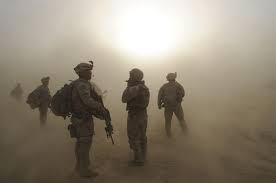GR: The U. S. military is taking climate change seriously. A new report released yesterday by the Department of Defense describes military preparations for the expected changes and efforts to reduce greenhouse gasses responsible for the changes.
2014 Climate Change Adaptation Roadmap. U. S. Department of Defense,
Department of Defense Climate Change Excerpt From the Foreword:

“The responsibility of the Department of Defense is the security of our country. That requires thinking ahead and planning for a wide range of contingencies. Among the future trends that will impact our national security is climate change. Rising global temperatures, changing precipitation patterns, climbing sea levels, and more extreme weather events will intensify the challenges of global instability, hunger, poverty, and conflict. They will likely lead to food and water shortages, pandemic disease, disputes over refugees and resources, and destruction by natural disasters in regions across the globe. In our defense strategy, we refer to climate change as a “threat multiplier” because it has the potential to exacerbate many of the challenges we are dealing with today – from infectious disease to terrorism. We are already beginning to see some of these impacts.
A changing climate will have real impacts on our military and the way it executes its missions. The military could be called upon more often to support civil authorities, and provide humanitarian assistance and disaster relief in the face of more frequent and more intense natural disasters. Our coastal installations are vulnerable to rising sea levels and increased flooding, while droughts, wildfires, and more extreme temperatures could threaten many of our training activities. Our supply chains could be impacted, and we will need to ensure our critical equipment works under more extreme weather conditions. Weather has always affected military operations, and as the climate changes, the way we execute operations may be altered or constrained. While scientists are converging toward consensus on future climate projections, uncertainty remains. But this cannot be an excuse for delaying action. Every day, our military deals with global uncertainty. Our planners know that, as military strategist Carl von Clausewitz wrote, “all action must, to a certain extent, be planned in a mere twilight.” It is in this context that DoD is releasing a Climate Change Adaptation Roadmap. Climate change is a long-term trend, but with wise planning and risk mitigation now, we can reduce adverse impacts downrange. Our first step in planning for these challenges is to identify the effects of climate change on the Department with tangible and specific metrics, using the best available science. We are almost done with a baseline survey to assess the vulnerability of our military’s more than 7,000 bases, installations, and other facilities. In places like the Hampton Roads region in Virginia, which houses the largest concentration of US military sites in the world, we see recurrent flooding today, and we are beginning work to address a projected sea-level rise of 1.5 feet over the next 20 to 50 years. Read more.
